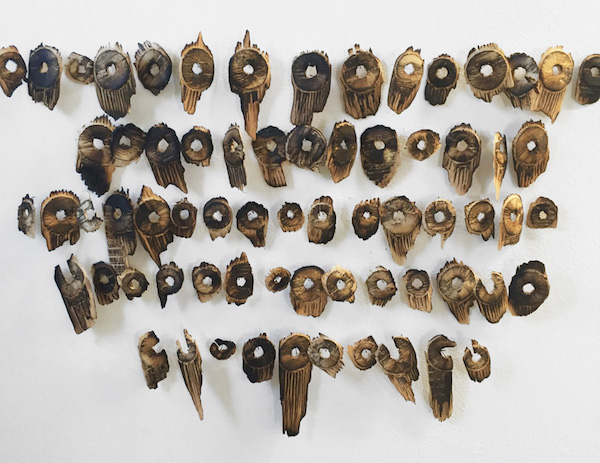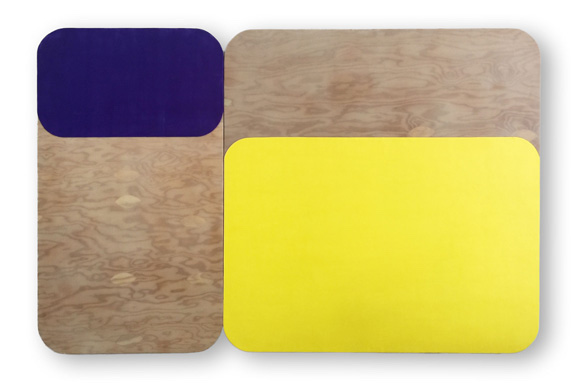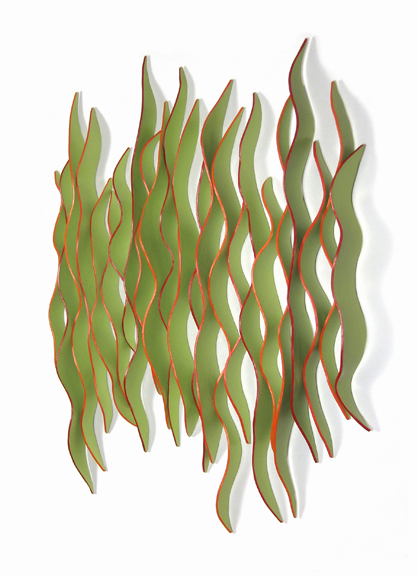By Shelley Gilchrist

Christine Aaron, Murmur, 2013, multiple 36 x 102 inches lithographic monoprints on gampi with multitrack audio (continuous recorded vocal memories, layered with ambient sounds of rain, wind and trees)
.
“Just rearranging the deck chairs.” An overheard sotto voce criticism such as this can evoke despair, even existential crisis, in the toughest among us. In this case, I heard the remark from a Chicago artist many years ago. Perusing his freshly hung solo show of figurative pastel drawings, he uttered that on-the-spot reaction to seeing them presented together for the first time. Over the past five years, he concluded, he had not made anything new.
He must have brooded about this insight, because less than two years later he showed new work: oil paintings in which he explored the surface with varied brush strokes and used dynamic angles and cropped views in his representation of the figure. By picking up a brush he rescued himself from despondency, jump-started his art and, you could say, mercifully saved the rest of us from another series of centered frontal-seated nudes.
As an artist who has found switching mediums a rejuvenating process well worth the learning curve, I keep those deck chairs in the back of my mind, and try to move on before I find myself moving furniture. In recent years I have shifted sequentially from figurative oil painting on canvas, to gouache on panel, to figurative encaustic paintings on panel, to abstract encaustic painting on shaped panel to—at present—acrylic on 3-D surfaces. But I’m just one of many ProWax artists who find value in switching up their materials, sometimes using distinct mediums to make separate bodies of work concurrently. Here, eight of us talk about fluency in more than one medium, even when that one medium is as beloved for its aesthetic and physical qualities as wax.
.
Christine Aaron
After taking an encaustic workshop some 10 years ago, Christine immediately expanded her first medium, the inks and plates of printmaking, into mixed media using prints. She enjoys the versatility of wax, especially in combination with other materials, and continues to derive ideas for the future from the concepts and materials of the present, often revisiting earlier ideas with new materials as a means to fresh expression. Regardless of the learning curve for acquiring different mediums (“challenging,” says Christine), she finds the process of inquiry stimulating as it leads to new paths and reveals new ways to explore the inherent qualities of her materials–conceptually and metaphorically—as well as materially. Recent formal explorations have led her to sculpture and installation while she continues to “work back and forth across mediums.” She adds, “Hopefully, my ‘voice’ and artistic viewpoint carry across the work’s various forms and iterations.”

Forest Muse II, 2015, lithograph and encaustic on patinated copper, 24 x 24 inches
What We Keep, 2016, burned and drilled plywood, dimensions variable

Jane Guthridge
Working within the crosscurrents of different media helps Jane move her work forward. “I am continually exploring new ideas and trying to figure out ways to get there,” says Jane. She discovered wax well into her art career, first making monotypes and then discovering that other materials work well with wax as she pursued her enduring investigation of luminosity: “Light itself is now the most important medium I use, and I think that the use of wax has led me to using light as a medium.” Typically Jane makes three to five works in one medium, and then switches (changing studio set-ups) to another. She uses Dura-Lar, sheet metal, and photos embedded with wax in creating her 2- and 3-D pieces, as well as installations–many forms expressing her interest in the “transcendent experience of light in nature.”

Reflected Light (installation detail), 2016, cut Dura-Lar, acrylic, invisible cord
The Space Between 23, 2012, layered encaustic monotypes and archival inkjet on Asian paper, 19 x 19 inches

Tracey Adams
Like Jane Guthridge, Tracey was well into her 2-D art practice when her interest was piqued by wax. For her it was a Michael David exhibit of encaustic paintings in New York 20 years ago. Trained in drawing, painting and printmaking in college, Tracey then took an encaustic workshop and proceeded to experiment with wax in combination with her then-primary mediums. She continues to make drawings, prints and collages, both with and without wax, relying on ink, graphite or gouache for complex mark-making. For an exhibit this fall Tracey will show two bodies of work, one complex: collage paintings in mixed media; and one more minimal: a group of encaustic monotypes on panel. She hopes that the distinct bodies of work will dialog. “I’m a restless artist and working with different materials creates an ongoing level of interest, challenge and inspiration, keeping my practice stimulating.”

Balancing Act, 2016; collage, ink, gouache on panel; 40 x 40 inches
Momentum Transferred, 2015, encaustic and oil on panel, 27 x 56 inches

Pamela Wallace
Pamela was making prints when, like Tracey Adams, she came across encaustic paintings on exhibit in a New York City gallery more than 15 years ago. She ordered supplies and courageously began to experiment on her own. When she added wax to her collagraphic prints, they “took on a whole new dimension.” Her wax-infused prints have had particular appeal to curators and gallery owners. She continues to work with wax alone and also employs mixed media, including various papers, metal leaf, and cut-up prints in collage, which may or may not include wax. Pamela usually experiments to see what mediums and techniques allow her to express her intentions “optimally,” stating, “my ideas are not medium specific.” While her work in one medium informs her work in others, due to constraints of studio space, she relies on notes and memory, rather than carrying out projects in different mediums simultaneously.

Basics, 2014, collagraph print on Rives BFK, 12 x 12 inches
Dogwood, 2016, collagraph print under wax and oilstick, 8 x 8 x I inches

Ruth Hiller
A self-taught painter, Ruth first used oil, watercolors and gouache. When she took a wax workshop in 2008, she was immediately smitten and made 200 encaustic paintings the first year. She subsequently used encaustic exclusively for eight years, first with transfers, then more minimally. Wax allows her to work quickly, allowing her to accomplish more work than oil painting. It was a natural step to exploring another fast-drying medium, acrylic. She completed a residency at the Golden Foundation in 2014, exploring acrylic paint’s qualities in depth. Ruth says the residency boosted her confidence about being a painter. “It became clear to me that it was not about the medium, but about how to use it to get your message across.” She has equal opportunities to exhibit both encaustic and acrylic, having created in the different media two series somewhat similar in style. Soft Geometry—encaustic on panel—led to Industrialized Nature, in which she has experimented with acylic on substrates such as linen and plexiglass.

Nehi, 2016, acrylic on plexiglass, 30 x 48 inches
Peterbilt, 2016, encaustic on panels, 48 x 76 inches

Joanne Mattera
In an art school elective, Joanne worked for the first time in encaustic. Many years later, she was making acrylic paintings and thread drawings on paper when she felt she had gained the patience and painting ability to bring wax into her practice. Infusing the paper with wax was a natural starting point, and the wax itself eventually became her chief painting medium. Nonetheless, Joanne exhibits work in all of the mediums she uses to explore her chromatic and geometric subject matter. “I identify as the painter I was trained to be, so the exhibition opportunities I’ve cultivated have come to me as an artist, no adjective required.” Her choice of materials is determined by her ideas. The sheen and luminosity of wax define her long-running Silk Road series; for works on the velvety surface of hot-press watercolor paper, she prefers matte gouache or graphite. “There’s an organic development from one series to another, as well as from painting to painting within a series, which advances the oeuvre.”

Soie, installation on studio wall, 2011, gouache on Arches, each 22 x 30 inches
Grid of nine paintings from Silk Road, 2014-2015, encaustic on panel, each 12 x 12 inches in a 44 x 44-inch grid installed at dm contemporary, New York City, January 2015

Corina Alvarezdelugo
Naturally curious about art and sculpture materials, Corina has worked in a variety of mediums. Although encaustic was never mentioned in art school, she discovered its possibilities by examining museum paintings. In 2009 she was inspired to take a wax technique workshop so that she could emulate a particular result in one of the works that was underway in her studio. Since folding wax into her practice, she has continued to experiment further with new materials. Occasionally she sets aside the idea she is pursuing and recharges her batteries by working spontaneously, free of (albeit self-imposed) restrictions and goals. Having multiple skills and materials at her disposal enables her to choose ways to deliver her message. “The ability to work in different mediums gives me that freedom I need, while at the same time it helps me to expand on the story I want to tell.”

Standing Tall IV, 2015; sumi ink, acrylic, charcoal, graphite on Canson; 48 x 48 inches
Soul Journey Towards Rebirth, 2013; encaustic, abaca paper, paper clay, indigo on wood; 18 inches diameter

Shelley Gilchrist
Recently I cleared my studio of a few years’ worth of material experiments–acrylic on thermoplastic, wax on epoxy clay, hot-wax-and-marker bleed tests, Duralar practice joints (fail, by the way)–as well as a fair number of samples whose purpose I no longer remember. The neophyte oil painter of 25 years ago would be astonished that so much of my practice now is devoted to exploring materials and solving problems.

Willows 1 (Essex), 2014, encaustic on shaped panel, each 30 x 8 ½ x ¾ inches
Rabbit-Proof, 2016, acrylic on epoxy clay, 29 x 26 x 2 ¼ inches

Some of us, like Corina, are curious about materials at the very outset and this can be a fascination that opens the door to artmaking. For others, this interest can unfold as our subject matter changes and, we often feel, demands a new medium. Some of us are restless souls who seek innovation in our practice. Yet, as all of us here attest, investigating different mediums is time well spent. Acquiring the ability to use materials to serve specific artistic purposes has served us well.
.
Thank you for such a wonderful peek into this beautiful work and the story of each artist.